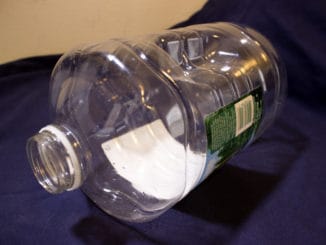Water is the most important resource in any survival scenario. Whether you are dealing with a natural disaster or the collapse of civilization, having water on hand will give you a better chance of survival. If you are prepping correctly, you should have a knowledge of exactly how much water you have and approximately how long it will last.The question many first time preppers ask is how much water should they store. The general rule is to have one gallon of water for each person for each day you anticipate being in survival mode. In a moderate climate, doing moderate physical activity, a healthy adult male requires 3 liters of fluid a day. Under the same conditions, a healthy adult female requires 2.2 liters. The best way to visualize this is to think of bottles of soda. A gallon of water is slightly more than 3 liters, so you are essentially storing more drinking water than you actually need to consume in a given day.
For a family of four, storing the required amount of drinking water for 180 day would equate to 720 gallons. If you live in an apartment or have a small home, this poses unique challenges. For the apartment dweller, storing this amount of water may not be feasible. Having to renew a lease every year or two means there is always the possibility that the apartment may be lost. Imagine the nightmare of having to move 720 gallons of water. The other challenge is the space needed. Having a family member with ample space could help with your prepping needs. Coordinate with this family member and include them in your plan. If needed, introduce them to prepping and help them get started. Pooling resources in a time of need may be the best option if you have limited resources. This does not mean you should become dependent on another for your survival needs, you are working together to aid in your long-term survival. The concept of co-prepping goes beyond the scope of this article and will be covered in detail at a later time.
Where exactly should the water be stored? In apartment living, the logical choice would be the kitchen, a closet or an area that is out of the way. Prepping should not be an obsession. The plan and provisions should be known and available, but they should not be in the way. Now, that all important question: How much water should be stored? As much as your dedicated space can hold, but no less than a 3 day supply for each person. That 3 day supply should not be your goal or the end of your plan. If you have a bug out or co-prepping location, you should have enough water to keep you until you can get to this location. One cannot assume that order will be restored in 3 days or disaster cleanup will be completed in that time. There should be a plan in place to obtain more water if you are unable to make it to your bug out location. Depending on the scenario, you may have to operate under different rules, in other words, you may have to steal water. One thing to remember is that you are responsible and will be held accountable for your actions once order is restored. Common sense should dictate when this type of action would be necessary.
I would not suggest entering the homes of others to take their resources because you cannot be sure what kind of security they have in place. This is also unfamiliar ground to you and that leaves you at a disadvantage. Going to a nearby convenience store or supermarket would be the best places to find water. These should be your primary targets the instant we have a true SHTF scenario. I consider a true SHTF scenario to be one that is sudden and widespread with no foreseeable end. I mention this because if there is enough warning, these things can hopefully be bought. You will just have to be among those who don’t prep and flock to the supermarket whenever there is a report about an impending storm. As a prepper, this is not a situation you want to find yourself in. You should already have your supplies and be heading to your bug out location, not standing on a line to buy supplies.
In a true SHTF situation, stores will more than likely be closed preventing you from buying water. You may not want to wait until you run low or run out of water before trying to obtain more. You should have multiple means to get to your targeted stores and transport the water. Be smart about where you go. The convenience store may be closer, but their supply of water will be limited. You may only have one opportunity to make this run, so it is important where you go. Getting as much water as possible should be your primary goal at this point. Any space you have should now be used to keep water. Along with bottled water, you may also want to steal storage containers. These containers can be used to store tap water, presuming you still have running water. You should also have multiple means of purifying water to ensure the tap water is safe to consume. But depending on the scenario, you will know whether tap water should be considered safe for use.
Apartment living brings unique limitations to prepping. Understanding these limitations will make you a better prepper. Since water is the most vital resource for survival, all options should be considered when it comes to obtaining it, even looting.



Soda bottles make excellent water storage. Rinse them well and learn how to properly store water in them. Got a bed? Raise it high enough to place upright soda bottles filled with water under it.